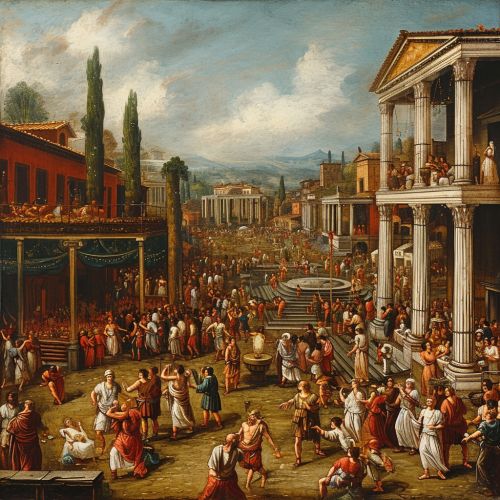Roman Festivals
Introduction
The Roman civilization, renowned for its rich cultural heritage, had a vibrant tradition of festivals. These festivals, known as feriae in Latin, were an integral part of Roman society, serving as a means to honor the gods, commemorate significant historical events, and provide entertainment. This article delves into the various aspects of Roman festivals, exploring their origins, significance, and the rituals associated with them.
Origins and Types of Festivals
Roman festivals originated from the religious beliefs and agricultural practices of the early Roman society. The Romans believed that their gods had a direct influence on their daily lives and the functioning of the state. As a result, they held numerous festivals throughout the year to appease these deities and ensure their favor. These festivals can be broadly classified into three categories: feriae stativae, feriae conceptivae, and feriae imperativae.


Feriae Stativae
Feriae stativae were annual festivals that had fixed dates on the Roman calendar. These festivals were primarily religious in nature and were dedicated to specific deities. Some of the most significant feriae stativae included the Lupercalia, a festival dedicated to the god Faunus and the legendary she-wolf who nursed Rome's founders, Romulus and Remus; the Saturnalia, a mid-winter festival honoring Saturn, the god of agriculture and harvest; and the Vestalia, a festival dedicated to Vesta, the goddess of the hearth.
Feriae Conceptivae
Feriae conceptivae were festivals that did not have fixed dates and were scheduled by priests or magistrates. These included the Ambarvalia, a festival that involved the blessing of fields and crops, and the Compitalia, a festival honoring the Lares Compitales, the guardian spirits of crossroads.
Feriae Imperativae
Feriae imperativae were festivals called for special occasions, such as military victories or times of crisis. These were usually declared by the Senate or other high-ranking officials. An example of a feriae imperativae is the Supplicatio, a public prayer or thanksgiving declared by the Senate in response to significant military victories or other favorable events.
Rituals and Celebrations
The rituals associated with Roman festivals were diverse and often complex, involving sacrifices, processions, games, and feasting. The specific rituals varied depending on the nature of the festival and the deity being honored.
Sacrifices
Sacrifices were a common feature of Roman festivals. Animals such as bulls, sheep, and pigs were often sacrificed to the gods in elaborate rituals known as sacra. The type of animal sacrificed usually corresponded to the nature of the deity being honored. For instance, Mars, the god of war, was often offered a bull, while Ceres, the goddess of agriculture, was typically offered a sow.
Processions
Processions were another integral part of Roman festivals. These were grand parades that often involved the carrying of images of the gods through the streets of Rome. The processions served to display the wealth and power of Rome and its devotion to the gods.
Games
Many Roman festivals included games (ludi) as part of the celebrations. These games, which could include chariot races, gladiatorial contests, and theatrical performances, were often held in public venues such as the Colosseum or the Circus Maximus. The games served both as entertainment for the populace and as a means to honor the gods.
Feasting
Feasting was a common feature of Roman festivals. During these feasts, Romans would gather to eat, drink, and celebrate. These feasts were often lavish affairs, with a wide variety of food and drink available. They served as a means for Romans to display their wealth and generosity, and also provided an opportunity for social interaction.
Impact on Society and Culture
Roman festivals had a profound impact on Roman society and culture. They served as a means to reinforce social norms and values, promote civic unity, and express religious devotion. Moreover, they provided a platform for political expression and a means for the elite to display their wealth and power.
Conclusion
Roman festivals, with their rich rituals and celebrations, were a vital part of Roman society and culture. They served not only as a means to honor the gods and ensure their favor, but also as a platform for social interaction, political expression, and cultural display. Even today, the influence of these festivals can be seen in many aspects of Western culture, from our calendar to our public celebrations.
